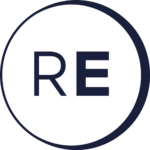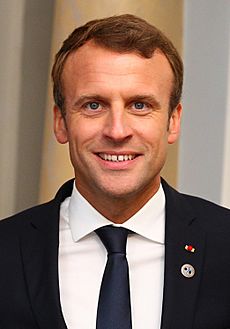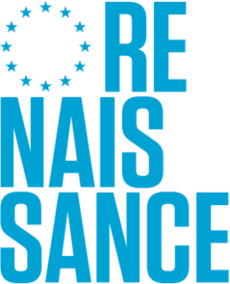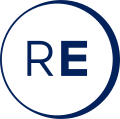Renaissance (French political party) facts for kids
Quick facts for kids <div style="padding-top:0.3em; padding-bottom:0.3em; border-top:2px solid Lua error in Module:European_and_national_party_data/config at line 227: attempt to index field 'data' (a nil value).; border-bottom:2px solid Lua error in Module:European_and_national_party_data/config at line 227: attempt to index field 'data' (a nil value).; line-height: 1;">
Renaissance
|
|
|---|---|
 |
|
| Abbreviation | RE |
| General Secretary | Gabriel Attal |
| Honorary President | Emmanuel Macron |
| Leader in the National Assembly | Gabriel Attal |
| Leader in the Senate | François Patriat |
| Founder | Emmanuel Macron |
| Founded | 6 April 2016 17 September 2022 (as Renaissance) |
| Split from | Socialist Party The Republicans |
| Headquarters | 68, Rue du Rocher 75008 Paris |
| Youth wing | Les Jeunes en marche |
| Membership (June 2025) | |
| Ideology | Liberalism (French) |
| Political position | Centre to centre-right |
| National affiliation | Ensemble |
| European Parliament group | Renew Europe |
| Colours |
|
| National Assembly | Lua error in Module:European_and_national_party_data/config at line 227: attempt to index field 'data' (a nil value). |
| Senate | Lua error in Module:European_and_national_party_data/config at line 227: attempt to index field 'data' (a nil value). |
| European Parliament | Lua error in Module:European_and_national_party_data/config at line 227: attempt to index field 'data' (a nil value). |
| Presidency of departmental councils |
2 / 95
<div style="background-color: Lua error in Module:European_and_national_party_data/config at line 227: attempt to index field 'data' (a nil value).; width: 2%; height: 100%;">
|
| Presidency of regional councils |
1 / 17
<div style="background-color: Lua error in Module:European_and_national_party_data/config at line 227: attempt to index field 'data' (a nil value).; width: 6%; height: 100%;">
|
| Website | |
| Lua error in Module:European_and_national_party_data/config at line 227: attempt to index field 'data' (a nil value). | |
|
^ A: Along with centre-right, the party has also been described as radical centrist, right-wing, or a big tent/catch-all party. |
|
Renaissance (RE) is a political party in France. It is often described as a party that supports liberalism and is in the centre or centre-right of politics. The party was first called En Marche ! (EM) and later La République En Marche ! (meaning "The Republic on the Move," LREM). It changed to its current name, Renaissance, in September 2022. Renaissance is the main part of the Ensemble group, which supports Emmanuel Macron.
The party was started on April 6, 2016, by Emmanuel Macron. He was a former Minister of the Economy. Macron was later elected president in the 2017 presidential election. After that, the party ran candidates in the 2017 legislative election. They won a majority of seats in the National Assembly. Macron was re-elected in the 2022 presidential election. However, the party lost its majority in the 2022 legislative election.
Macron created Renaissance to be a progressive movement. It aimed to bring together ideas from both the left and right sides of politics. The party supports pro-Europeanism, which means working closely with other European countries. It also supports globalization, which is about countries connecting more with each other. Renaissance wants to make French politics more modern and fair. The party has welcomed members from other political groups. It does not charge fees for people to join. Since June 2019, the party has been a founding member of Renew Europe. This is a group in the European Parliament for liberal and centrist parties.
Contents
History of Renaissance
How the Party Started
Emmanuel Macron started En Marche! on April 6, 2016, in Amiens. He was 38 years old at the time. The name "En Marche!" has the same initials as Macron's own name.
When En Marche! was announced, it was the first sign that Macron might run for President. He used the party to raise money for his possible presidential campaign. Many people in the media talked about the party's launch. Macron's popularity grew quickly in opinion polls. He became seen as a strong candidate.
To create the party's first ideas, Macron and his team asked 4,000 volunteers to talk to 100,000 people. They went door-to-door to ask questions. This information helped them create a plan that was closer to what French voters wanted.
2017 Legislative Election
La République En Marche! (the party's name at the time) had candidates in most areas. At least half of their candidates were new to politics. The other half had been in political office before. Half of their candidates were also women. Candidates could not run in more than one area. Macron also said that candidates needed to be honest and represent different ideas.
People who wanted to be candidates for the party had to sign up online. Nearly 15,000 people applied. To run under the party's name, politicians from other parties had to leave their old parties. However, Macron later changed this rule. They could stay in their old parties as long as they supported him.
On May 15, 2017, Édouard Philippe became the Prime Minister. He was a member of another party, The Republicans.
On June 18, 2017, La République En Marche! won a clear majority in the National Assembly. They won 308 out of 577 seats. This made them the main party in power, supporting the President.
2017 Senate Election and First Party Meeting
In the 2017 Senate election, La République En Marche! won fewer seats than they hoped. They ended up with 21 seats. The Senate election system is different. Senators are chosen by other elected officials, not directly by the public. Because the party was new, this system made it harder for them to win many seats.
In the same month, the party held its first big meeting in Lyon. The party's spokesperson, Christophe Castaner, became the leader of the party. He was elected for a three-year term.
The party lost its first seat in the National Assembly in a special election. This showed that support for the party had changed since the 2017 elections.
2019 European Parliament Election
La République En Marche! ran a campaign for the 2019 European Parliament election. Macron called his campaign "Renaissance". He wanted to see a "renaissance" (a rebirth or new beginning) across Europe. After the election, the group they joined in the European Parliament changed its name to Renew Europe. This group includes Macron's Renaissance party and others.
2020 Local Elections
For the 2020 local elections, La République En Marche! wanted to win many local council seats. The party supported candidates in many towns.
The party did not win any major cities in these elections. They only had 146 mayors who were supported by the party in towns with more than 9,000 people. In many cities, the party finished in third or fourth place. For example, in Paris and Lyon, the party's candidates did not do well. Environmental parties won most of the big cities that La République En Marche! had hoped to win.
The party faced challenges during this time. There were protests by the Yellow Vests. There were also disagreements about pensions and climate change. The start of the COVID-19 crisis also made things difficult for the party.
2022 Legislative Election
In May 2022, La République En Marche! announced that its group in the parliament would be called Renaissance. In September, the party itself also changed its name to Renaissance. This change was part of a plan to bring all the parties that support the president into one big party. Some smaller parties, like Agir and Territories of Progress, joined Renaissance.
2024 Legislative Election
President Macron called for a new legislative election after the 2024 European Parliament election.
What Renaissance Believes In
Renaissance aims to go beyond the usual political divisions of left and right. It wants to be a party that brings different ideas together.
People have described the party in different ways. Some say it is centrist, meaning it is in the middle. Others say it is centre-right. Some even call it a "big tent" party, meaning it tries to include many different kinds of people and ideas.
In 2016, Macron said the party was progressive. He meant it combined ideas from both the left and the right. In 2017, experts said the party supports cultural liberalism, social liberalism, and economic liberalism. This means they believe in individual freedoms, social progress, and free markets.
The party has also been described as using strategies that challenge the traditional political system. They are sometimes compared to the "Third Way" approach used by the Labour Party in the UK. This approach tries to find a middle ground between traditional left and right ideas.
A survey in March 2018 showed that many people saw the party as moving more towards the right. About 45% of people thought it was centre-right or right-wing.
Partner Parties
Renaissance works with other political parties. Some of these parties have joined Renaissance. Others are partners in the larger "Ensemble" group.
| Name | Main Idea | Position | Leader | Current MPs | |
|---|---|---|---|---|---|
| Territories of Progress | Social liberalism, Social democracy | Centre to centre-left |
9 / 577
|
||
| Agir | Conservative liberalism, Pro-Europeanism | Centre-right |
4 / 577
|
||
| Ecologist Party | Green politics, Green liberalism | Centre-left | François de Rugy |
0 / 577
|
|
| Guiana Rally | Liberalism, Autonomism | Centre | Rodolphe Alexandre |
0 / 577
|
|
| United Guadeloupe, Solidary and Responsible | Centre | Guy Losbar |
0 / 577
|
||
How the Party Works
Party Symbols
Joining the Party

Anyone can become a member of Renaissance. They just need to provide some basic information like their name and email. They also agree to follow the party's rules. Unlike many other political parties, Renaissance does not ask members to pay money to join. Emmanuel Macron has said that people can join Renaissance even if they are already members of another party.
Soon after the party started, Macron said it had 13,000 members. Some people questioned this number. However, Macron's team explained that each member agrees to the party's values. They also get a say in the party's meetings.
In October 2016, Macron said that En Marche! had almost as many members as the Socialist Party. Many of its members were new to politics. The party encourages members to create or join local groups. These groups hold meetings and discussions about the party's ideas. By December 2016, there were more than 2,600 such groups.
Party Funding
Renaissance raises money to support its activities. In 2016, Macron said that 2,000 people had given money to the party. By December 2016, over 10,000 people had donated. The donations ranged from 1 euro to 7,500 euros. By the end of March 2017, the party had collected over 9 million euros. This came from 35,000 donations. The average donation was 257 euros.
European Representation
In the European Parliament, Renaissance is part of the Renew Europe group. They have members of the European Parliament (MEPs) in this group.
Renaissance also has members in the European Committee of the Regions. This committee represents local and regional governments in Europe.
Election Results
Presidential Elections
| Election year | Candidate | First round | Second round | Result | ||||
|---|---|---|---|---|---|---|---|---|
| Votes | % | Rank | Votes | % | Rank | |||
| 2017 | Emmanuel Macron | 8,656,346 | 24.01 | 20,743,128 | 66.10 | Won | ||
| 2022 | 9,783,058 | 27.85 | 18,768,639 | 58.55 | Won | |||
Legislative Elections
| Election year | Leader | First round | Second round | Seats | +/− | Rank (seats) |
Government | ||
|---|---|---|---|---|---|---|---|---|---|
| Votes | % | Votes | % | ||||||
| 2017 | Richard Ferrand | 6,391,269 | 28.21 | 7,826,245 | 43.06 |
308 / 577
|
1st | Presidential majority | |
| 2022 | Élisabeth Borne | 5,857,364 | 25.71 | 8,003,240 | 38.57 |
133 / 577
|
1st | Presidential minority | |
| 2024 | Gabriel Attal | 6,820,446 | 21.28 | 6,691,619 | 24.53 |
98 / 577
|
2nd | Presidential minority | |
European Parliament Elections
| Election | Leader | Votes | % | Seats | +/− | EP Group |
|---|---|---|---|---|---|---|
| 2019 | Nathalie Loiseau | 5,079,015 | 22.42 (#2) |
12 / 79
|
New | RE |
| 2024 | Valérie Hayer | 3,589,114 | 14.56 (#2) |
4 / 81
|
See also
 In Spanish: Renacimiento (partido) para niños
In Spanish: Renacimiento (partido) para niños
- La République En Marche group (Senate)
- Liberalism and radicalism in France
- List of political parties in France
- Renaissance group







